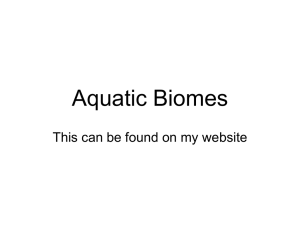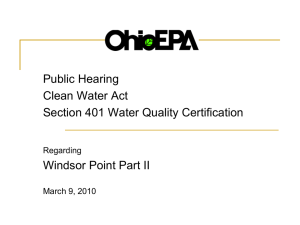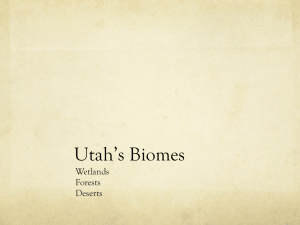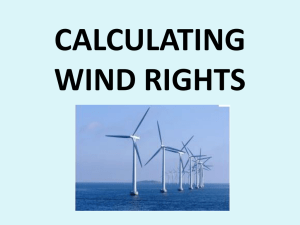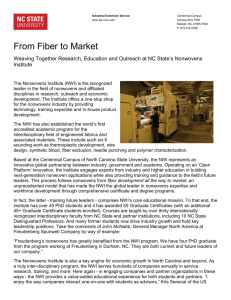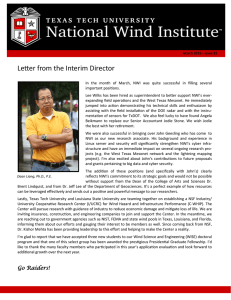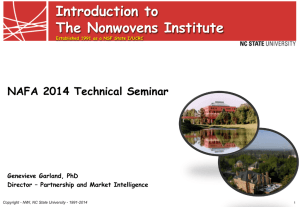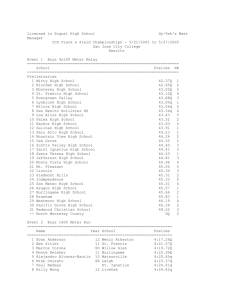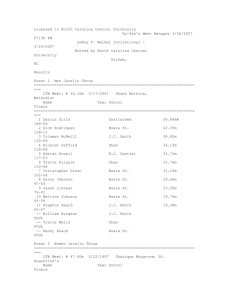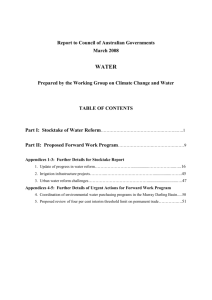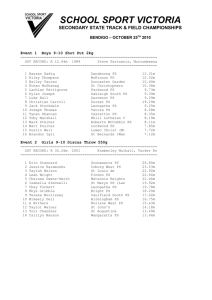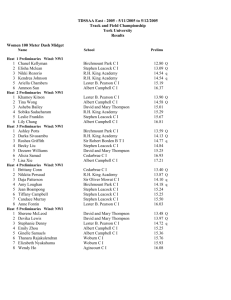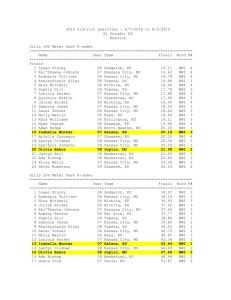National Wetlands Inventory Mapping In Vermont
advertisement
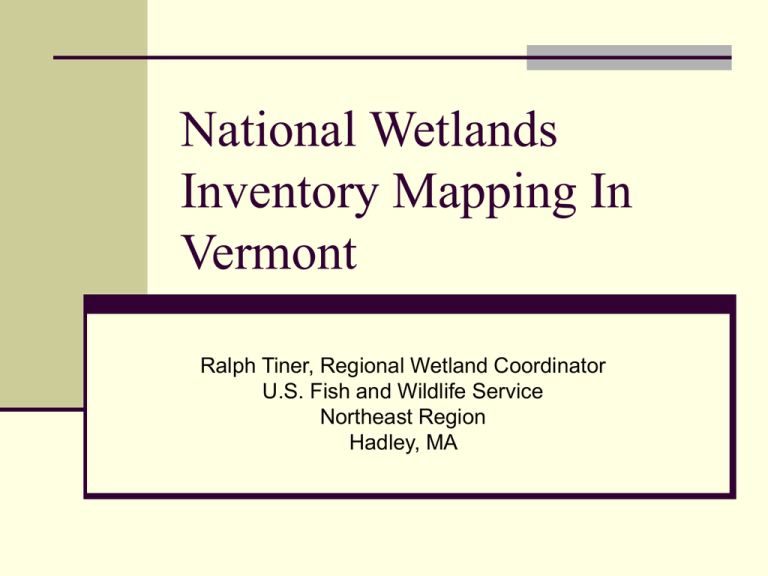
National Wetlands Inventory Mapping In Vermont Ralph Tiner, Regional Wetland Coordinator U.S. Fish and Wildlife Service Northeast Region Hadley, MA Background National Program 90% of coterminous US mapped 50% digitized Regional Status 12 of 13 states mapped Updating in progress on a FWS priority basis and where outside funding is received Purpose of Mapping To inventory wetlands across the nation for natural resource conservation purposes To identify and classify larger wetlands based on photointerpretation (recognizing limitations inherent in this approach) To report on the status and trends of US wetlands and for states as mapping is completed The NWI is not designed to map all the wetlands in any locality – that would require on-the-ground surveys applying wetland delineation techniques Limitations of Photointerpretation for Mapping Wetlands Photo Scale Seasonality (environmental conditions at time of photo capture) Photo Quality Wetlands that are difficult to photointerpret Photo Scale vs. Area Scale 1:80K 1:58K 1:40K 1:24K 1:12K Area In One Square Inch 1020 acres 540 acres ~250 acres 92 acres ~25 acres Photo Scale vs. Mapping Unit Photo Scale vs. Target Mapping Unit 1:80,000 = 3-5 acres 1:58,000 = 1-3 acres 1:40,000 = 1 acre 1:24,000 = 0.25-0.50 acre 1:12,000 = 0.10 acre 1:80K vs. 1:58K 1:40K vs. 1:24K 1:24K vs. 1:12K 1:80K vs. 1:40K 1:80K vs. 1:12K Photo Scale vs. # of Photos Scale 1:80,000 1:58,000 1:40,000 1:24,000 1:12,000 # of Photos/Quad 1 1.5 4 20 42 #Photos/VT* 160 240 640 3200 6720 *Estimates based on 58 sq. mi/quad and Vermont land surface area. May be approx. 220 quads (1:24K) covering the state Pen Width vs. Ground Distance Earlier maps were hand-drawn, so pen-width was a factor. Scale 000 (0.25mm) 0000 (0.18mm) 1:80K ~67ft ~50ft 1:58K 48ft 34ft 1:40K 33ft 23ft 1:24K 20ft 14ft 1:12K 10ft 7ft Scale Limits on Wetlands Not simply acreage dependent Relates to shape one-acre block vs. one-acre linear Relates to easy or difficulty of photointerpretation of type Wetland Type Easy to identify types Marshes, bogs, seasonally flooded swamps, ponds Harder to identify types Drier-end wetlands Evergreen forested wetlands Temporarily flooded wetlands Wetlands on slopes (seepage) Seasonality Environmental Conditions Leaf on vs. Leaf off Spring vs. Fall (leaf off) Ambient weather Water tables and flooding Extreme flooding vs. droughts Snow and ice Photo Quality Emulsion Black and White (panchromatic) True Color Color Infrared Resolution Processing (over vs. under exposed) Date (best available at 1:40K or smaller; now use DOQ/DOQQ) Original NWI Maps for Vermont 1:80,000 CIR October 1977 Target Mapping Unit = 3-5 acres Inventory done in late 1970s/1980. Mapping Procedures Photointerpretation Limited Field Work Consultation with Soil Surveys? (No hydric soils lists/indicators) Regional QC (spot checking) National QC (spot checking) NWI Results vs. Hydric Soils NWI Soil Data 220,000 acres 3.7% of the state 341,000 acres 5.5% Updated NWI Mapping 1:40,000 CIR 1992-1994 Target Mapping Unit = 1 acre Mapping Procedures Edit original NWI data Photointerpretation Limited field checking Consult with soil surveys (interpretation) Regional QC (entire photo) National QC (automated verification) Status of Updates in Vermont New Mapping Procedures (2006) Edit existing NWI data Photointerpretation on-screen DOQ or DOQQ base Limited field checking FWS QC, automated verification Add undeveloped hydric soil map units FWS QC, automated verification Enhanced NWI Current NWI database Add other descriptors: Landscape Position Landform Water Flow Path Waterbody Type Use data to predict wetland functions LLWW Descriptors Landscape Position Lotic, Lentic, Terrene Landform Floodplain, Basin, Flat, Fringe, Slope Water Flow Path Inflow, Outflow, Throughflow, Bidirectional Flow, Isolated Waterbody Type Pond and lake types, impounded rivers, etc. Functional Assessment 9 Functions for Inland Wetlands Surface Water Detention Streamflow Maintenance Nutrient Transformation Sediment Retention Shoreline Stabilization Fish and Shellfish Habitat Waterfowl/Waterbird Habitat Other Wildlife Habitat Conservation of Biodiversity Updated NWI - Highlights Smaller wetlands Refined boundaries Incorporates more hydric soil map units Can be enhanced to be more descriptive After enhancement, can use for preliminary functional assessments Still will not map all wetlands – need ground surveys applying delineation procedures to do this; potential vernal pool mapping through remote sensing

